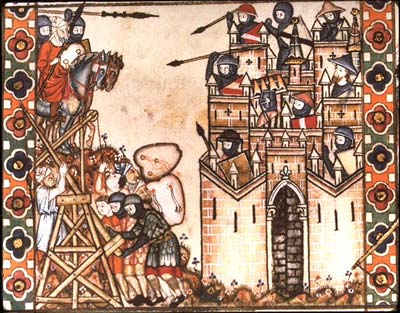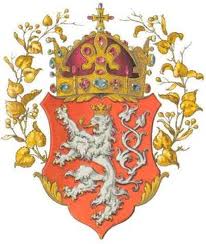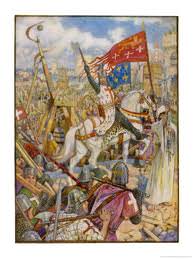Environmental impact of the Baltic Crusades: deforestation, animal extinction, dogs no longer on the menu
A multidisciplinary project seeks to understand the environmental impact of the Baltic Crusades. Horses, for example, aided the Christians in battle, while the castles the Crusaders built decimated forests.
Labyrinth, Part 2
So we continue with the exciting conclusion of last week’s two part mini-series, Labyrinth. Alice is being pursued by unsavory attackers, and Carcassonne has all but fallen.
The Indigenous Christians of the Arabic Middle East in an Age of Crusaders, Mongols, and Mamlūks (1244-1366)
The chronological period of study is highlighted by the usurpation of the Ayyūbid-ruled Sultanate by the Baḥrī Mamlūks, while the two most important political-military events in the region were the collapse of the Crusader States and the invasion of the Mongols. This thesis will examine how events impacted on the nine Christian Confessions, treating each separately.
Labyrinth
A review of Part 1 of author Kate Mosse’s, “Labyrinth”. Cathars, Crusaders and the Holy Grail!
Crusader sword sells for £163,250
A rare medieval sword, which had been given to the Mamluk rulers of Egypt and then looted from them by the same Crusader king, sold for £163,250 at auction this week, with an entire collection taking in bids over £ 1 million.
Conflicts of Ideology in Christian and Muslim Holy War
The holy wars of Christianity and Islam, crusade and jihad respectively, represent a conflict of ideology between two Abrahamic faiths that would be reignited with the First Crusade in 1096.
Hot Holiday Reads!
Put down those turkey left-overs and check out some of these hot holiday reads!
The Evolution of the Saladin Legend in the West
William of Tyreʼs account of the history of the Crusades stops suddenly in 1184. As he lays down his pen he is in despair at the inevitable outcome which he foresees for the struggle with Saladin. It was fortunate for him that he did not live to see the triumph of Saladin at Hattin and Jerusalem. Williamʼs judgement of Saladin, there- fore, is one of fear and admiration but he is also able to criticize his faults, especially his ruthless ambition.
Missionaries and Crusaders in Thomas Malory’s Morte d’Arthur
The War of Roses might have been the most prominent event on the English political stage at the time when the Morte d’Arthur was written, and there is evidence that Malory’s writing was in part informed by he civil discord he was witnessing.
Beneath the Battle: Engineers and miners as mercenaries in the Holy Land
Although the mercenary phenomenon was differently considered and regulated in the West, the practice of taking up arms in the service of a rival army is attested in the Latin East in the twelfth and thirteenth-century.
Salutare Animas Nostras: The Ideologies Behind the Foundation of the Templars
The meteoric rise of the Poor Fellow-Soldiers of Christ and the Temple of Solomon (more commonly known as the Knights Templar) and their equally swift fall has fueled fanciful tales and scholarly research. The order promoted their mythological origins and the extreme charges leveled against them by Philip IV of France (1285-1314) created an atmosphere of speculation.
God’s Warriors from the Czech Kingdom – the Terror of Central and Eastern Europe in the First Half of the 15th Century
The aim of this study is to point out a distinct phenomenon in the history of Central And Eastern Europe wherein part of the population of a fairly small kingdom in Central Europe invoked justified fear throughout the majority of Europe. Czech history is not all that popular a theme of study within the framework of European history. One of the few exceptions is the period of the first half of the 15th century in particular.
The Preaching of the First Crusade and the Persecutions of the Jews
In the spring and summer of 1096, bands of crusaders, at times with the help of the local population, destroyed Jewish life and property before leaving for the East.
Religion, Warfare and Business in Fifteenth Century Rhodes
How did a military-monastic order manage the resources of an island commercially asimportant as that of Rhodes while overcoming the limitations due to its patrimonial struc-tureto cover their defensive needs? In this essay weattempt to answer this question interms of practice and in the light of relationsthatthe Knights maintained with two distinctgroups of merchants: the Catalan-Aragonese and the Florentines.
Crusaders in Crisis: Towards the Re-assessment of the Origins and Nature of the “People’s Crusade” of 1095-1096
In his Historia Ierosolymitana, completed within one generation of the First Crusade, Albert of Aachen tells a curious story about some rustics, guided by divinely inspired goose and a she-goat to take the holy path to Jerusalem.
The remarkable Baldwin IV: leper and king of Jerusalem
Medieval teen king, precocious politician, and successful battlefield commander, Baldwin IV not only surmounted disabling neurological impairment but challenged the stigma of leprosy, remarkably continuing to rule until his premature death aged twenty-three.
Nomadic Violence in the First Latin Kingdom of Jerusalem and the Military Orders
That the threat posed by bands of marauders was taken seriously by the early crusader settlers can be seen by some of the barons’ brutal reactions to it.
Character-Assassination: Conrad de Monferrat in English-language Fiction and Popular Histories
It is a story will all the ingredients of epic tragedy: a brilliant, courageous and handsome nobleman travels to distant lands, fights battles, marries princesses, is elected King but is slain by treachery, still relatively young, just before he is crowned.
Tolerance for the People of Antichrist: Life on the Frontiers of Twelfth-Century Outremer
Professor Jay Rubenstein deals with a fascinating aspect of the early Crusaders – how these Western European holy warriors quickly adopted the lifestyles and practices of the East, just within a few years of conquering the area.
Mandeville’s Intolerance: The Contest for Souls and Sacred Sites in The Travels of Sir John Mandeville
While Chaucer‟s knight has traveled to and fought in Spain, North Africa, Eastern Europe, and Asia Minor, Sir John claims to have visited the entire known world from Constantinople and the Holy Land to the farthest reaches of Asia.
Through the Eyes of a Crusader: An Intensive Study Into the Personal Involvement of Two Men in the Fourth Crusade
What was going through the minds ofthese men who were fighting for the cross when they attacked a Christian city, which was one oftheir allies?
God, Gold, or Glory: Norman Piety and the First Crusade
The Normans remain as the standard bearer of the pre-revisionist interpretation of crusader motives – for gold and glory, but not for God. However, examination of the evidence does not bear this distinction out.
Catholic, Crusader, Leper and King: The Life of Baldwin IV and the Triumph of the Cross
Baldwin IV was born in Jerusalem of King Amalric and Queen Agnes of Courtney in 1161. Intellectually
and physically gifted as a boy, he seemed well equipped to inherit the Crusader kingdom.
The Great Men of Christendom: The Failure of the Third Crusade
It is my intention to show that the participation of monarchs in the Third Crusade had an adverse effect on the outcome of the Crusade. Whatever positive aspects of monarchical involvement in the Third Crusade were to be had can be seen at the beginning of the venture, when the Church needed financial and material support, as well as the prestige that royal participation could offer.
The papacy and the crusaders in the East, 1100-1160
This dissertation attempts to illuminate papal policy towards the Crusaders in the East by an analysis of the relationships of: 1) the Byzantine Empire to the Papacy and the Crusaders; 2) the Papacy to the spiritual and temporal powers of the Latin Orient; 3) the Papacy to the crusade movement in Europe and to Christendom as a whole













